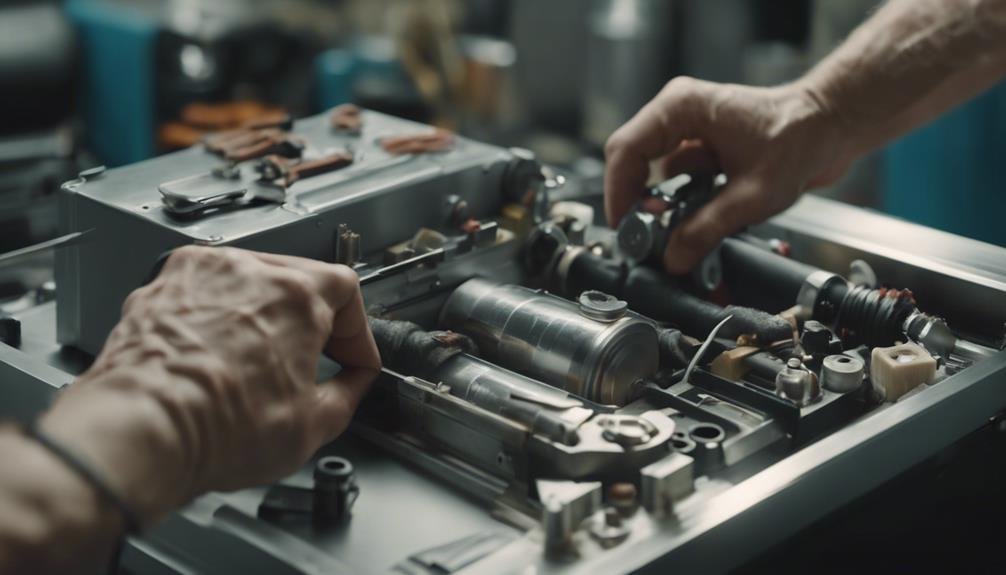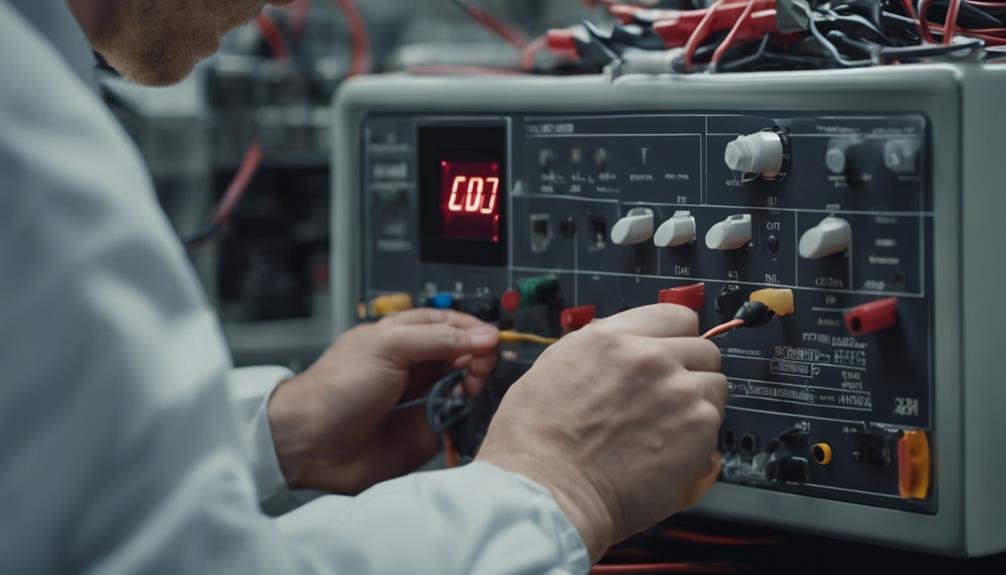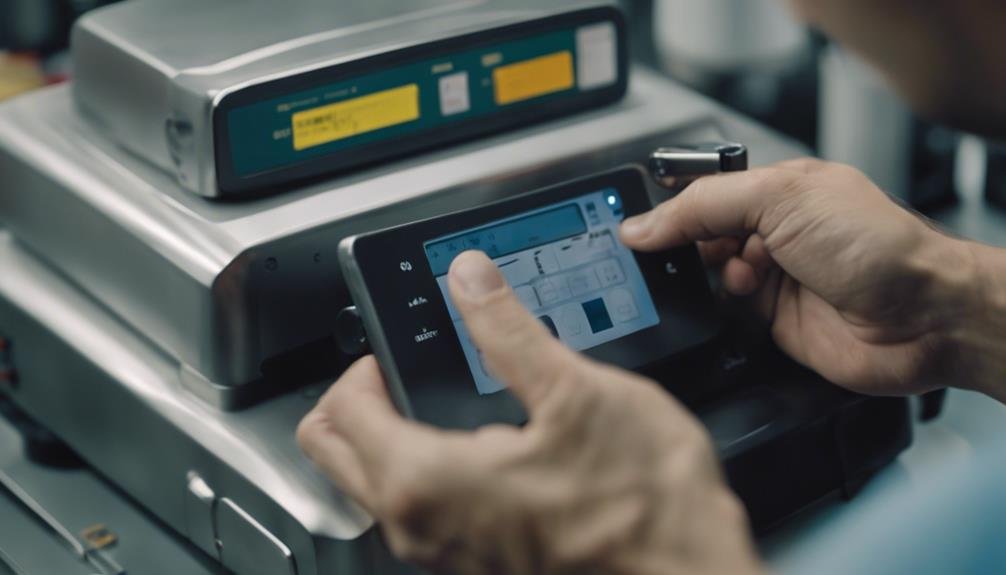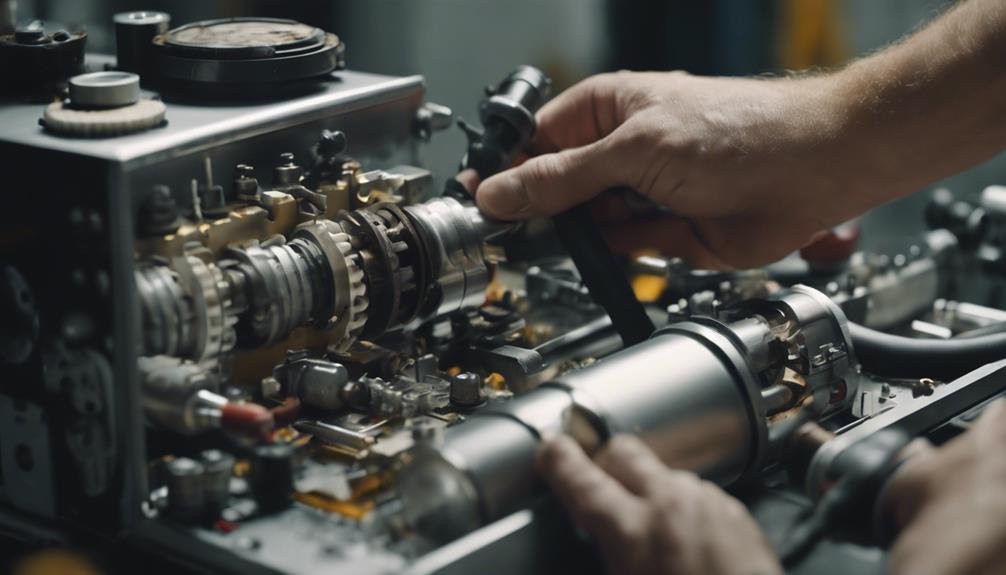When troubleshooting motor issues in your vacuum sealing machine, start by checking the power connection. Examine the cord and outlet for any damage, and ensure that the motor's wiring connections are secure. Unplug the machine and inspect the motor housing for any obstructions, carefully clearing away debris. Regularly clean the motor surface with a soft brush to maintain proper airflow. Look for any signs of damage like cracks or frayed wires on the motor, and test it using a multimeter. If problems persist, consider reaching out to the manufacturer or seeking professional repair services. By paying attention to these details, you can keep your machine running smoothly for longer.
Inspect Power Connection
To begin, check the power cord for any frays, cuts, or damage. When dealing with vacuum sealers, a compromised power cord can prevent the motor from operating efficiently. Look closely at the entire length of the cord to spot any visible wear and tear. If you find any, it's important to replace the cord to make sure your vacuum sealer receives a consistent power supply.
Next, make sure the power cord is securely plugged into a functioning power outlet. An unsecured connection or a faulty outlet can lead to intermittent power issues, affecting the motor's performance. Test the outlet with another device to confirm it's working correctly.
Additionally, inspect the motor's wiring connections inside the vacuum sealer. Loose or disconnected wires can easily disrupt the power flow, leading to motor problems. Carefully check each connection, ensuring everything is tight and secure.
For a more detailed diagnosis, use a multimeter to verify that the motor is receiving the correct voltage. Incorrect voltage can impede the motor's function, so this step is important. If you're still experiencing issues despite these checks, it might be time to consult a professional technician for further assistance.
Check for Obstructions
Before diving into complex repairs, inspect the vacuum sealer's motor for any debris or obstructions that might be affecting its performance. First, unplug the vacuum machine to guarantee safety. Carefully open the motor housing and look for any foreign objects or blockages. Even small debris can hinder the motor's operation, leading to inefficient sealing or complete motor failure.
Gently clear out any obstructions you find using a soft brush or compressed air. Pay special attention to nooks and crannies where dirt tends to accumulate. Removing these blockages can often solve the problem without needing more extensive interventions. Also, look for any signs of wear or damage on the motor components. Cracked or broken parts may require repair or replacement to restore the vacuum machine to its best functionality.
Regularly maintaining and cleaning the motor can prevent many issues from arising in the first place. By ensuring the motor is free from any dirt or residue, you can extend the lifespan of your vacuum machine and keep it running smoothly. Don't neglect this simple yet important step in your troubleshooting process; it can save you a lot of time and hassle down the line.
Clean the Motor

After clearing any obstructions, you should regularly clean the motor to maintain peak performance. Dust and debris can accumulate on the motor, hindering its efficiency. To clean the motor, use a soft brush or cloth. Gently remove any dust and debris from the motor's surface. Ensuring proper airflow around the motor is essential for its cooling, so make sure to reach all accessible areas.
Avoid using water or any liquid cleaners, as these can cause damage or create electrical hazards. It's best to stick to dry cleaning methods to keep your motor safe. While cleaning, take a moment to inspect the motor for any signs of overheating or unusual noises. These could indicate underlying issues that need attention.
Regular maintenance, including cleaning, plays a significant role in extending the lifespan and efficiency of your vacuum sealing machine. By keeping the motor clean, you ensure it operates smoothly and avoids unnecessary strain. Remember, a well-maintained motor not only performs better but also helps prevent more serious and costly repairs down the line. So, make cleaning the motor a routine part of your vacuum sealing machine's upkeep.
Examine for Damage
Start by carefully inspecting the motor for any visible signs of damage, such as cracks, frayed wires, or loose connections. These issues can seriously impact the performance of your vacuum sealing machine. Pay close attention to the motor casing and the areas where wires connect to make certain everything looks intact.
Here's a quick checklist to guide you:
- Check for physical damage: Look for cracks in the motor casing or any exposed, frayed wires. This could be a sign of wear that needs immediate attention.
- Overheating signs: Smell for any burnt odors or check for discoloration on the motor. These are clear indicators that the motor may have overheated at some point.
- Motor brushes: Inspect the motor brushes to see if they are worn down. Worn brushes can lead to poor performance or even motor failure.
- Continuity and voltage: Use a multimeter to test the motor for proper voltage and continuity. This guarantees the motor is receiving and transmitting electrical signals correctly.
Test the Power Source

To guarantee your vacuum sealing machine's motor is functioning correctly, you'll need to test the power source using a multimeter. Start by unplugging the machine and then inspect the power cord for any visible damage. Once you're sure the cord is intact, plug the machine back in and set your multimeter to the appropriate voltage setting. Carefully touch the multimeter probes to the power terminals of the vacuum pump's motor. You should see a reading that matches the voltage specifications outlined in your manufacturer's manual.
Next, it's crucial to examine all connections and wires leading to the motor. Loose connections or damaged wires can disrupt the motor's power supply. If you find any issues, tighten the connections or replace the damaged wires promptly.
To further ensure the motor is getting power, check the circuit and switches connected to it. Flip the switches on and off while monitoring the multimeter to see if there's consistent voltage flow.
Lastly, keep an eye out for signs of overheating, unusual noises, or burning smells coming from the vacuum pump. These indicators can suggest deeper issues that may require professional attention. By thoroughly testing the power source, you'll be one step closer to resolving motor problems in your vacuum sealing machine.
Assess Motor Functionality
Begin by checking for any power supply issues, such as blown fuses or tripped circuit breakers, that could impact the motor's operation. These issues often cause the vacuum sealing machine to malfunction. Once you've verified a stable power supply, proceed with the following assessments:
- Inspect the Motor: Look for signs of overheating, unusual noises, or physical damage. These indicators often point to underlying motor problems that need addressing.
- Test Continuity: Using a multimeter, check if the motor is receiving and transmitting electrical signals properly. A lack of continuity can indicate internal motor issues.
- Check Wiring Connections: Examine all wiring connections for looseness or disconnection. Loose wires can impede motor performance and functionality.
- Consult the Manual: Refer to your vacuum sealing machine's manual. It often contains specific troubleshooting steps tailored to your model, which can be invaluable.
Contact Manufacturer

Reaching out to the manufacturer can provide you with expert guidance and support for resolving motor issues in your vacuum sealing machine. When you contact the manufacturer, you're tapping into a wealth of knowledge that can help identify and solve the problem efficiently. Manufacturers often have detailed troubleshooting steps tailored specifically to your machine model. These steps can be invaluable, especially if you're unsure where the issue lies.
Manufacturers also have access to original parts and technical specifications, ensuring that any replacement components are a perfect fit for your machine. This can prevent further issues down the line. Additionally, they may recommend certified technicians who are trained to handle your specific machine, providing more reliable and effective repairs.
Direct communication with the manufacturer can expedite the resolution process. They can quickly advise you on whether the issue can be solved with a simple fix or if it requires more in-depth repair. This helps you avoid unnecessary downtime and gets your vacuum sealing machine back to peak performance faster. By seeking assistance from the manufacturer, you're taking a proactive step toward an efficient and effective solution for your motor problems.
Seek Professional Repair
When manufacturer support isn't sufficient, it's wise to seek professional repair services to make sure your vacuum sealing machine's motor is properly diagnosed and fixed. Experienced technicians have the specialized knowledge and tools needed to address motor issues effectively. This approach not only prevents further damage but also guarantees safe operation, extending the lifespan of your machine.
Here are some reasons why professional repair is beneficial:
- Proper Diagnosis: Technicians can pinpoint the exact issue with your motor, avoiding guesswork and potential mistakes.
- Specialized Tools: Pros have access to tools and equipment that most people don't, ensuring a more precise repair.
- Safety: Handling motor repairs yourself can be risky. Professionals adhere to safety standards, reducing the risk of injury.
- Longevity: A well-repaired motor can extend the overall life of your vacuum sealing machine, maintaining its efficiency.
Perform Regular Maintenance

Regular maintenance of your vacuum sealing machine's motor is crucial to keep it running smoothly and prolong its lifespan. By taking a few simple steps, you can guarantee your motor remains in top condition.
First, regularly clean the motor and surrounding areas. Dust and debris can accumulate over time, leading to overheating and reduced efficiency. Use a soft brush or compressed air to remove any buildup. This simple step can prevent major issues down the line.
Next, don't forget about lubrication. The moving parts of the motor need to be well-lubricated to reduce friction and wear. Check your machine's manual for the recommended type of lubricant and apply it according to the instructions. This will help your motor run more quietly and last longer.
Also, inspect the motor for loose connections or worn-out components. Tighten any loose screws and replace any parts showing signs of wear. This proactive approach can save you from unexpected breakdowns and costly repairs.
Conclusion
If you follow these steps, you'll likely get your vacuum sealing machine running smoothly again. For instance, Jane noticed her machine wouldn't start. She checked and cleaned the motor, found a loose wire, and reconnected it. Her machine worked perfectly after. Remember, regular maintenance can prevent many issues. If all else fails, don't hesitate to contact the manufacturer or seek professional repair to avoid further damage. Happy sealing!
